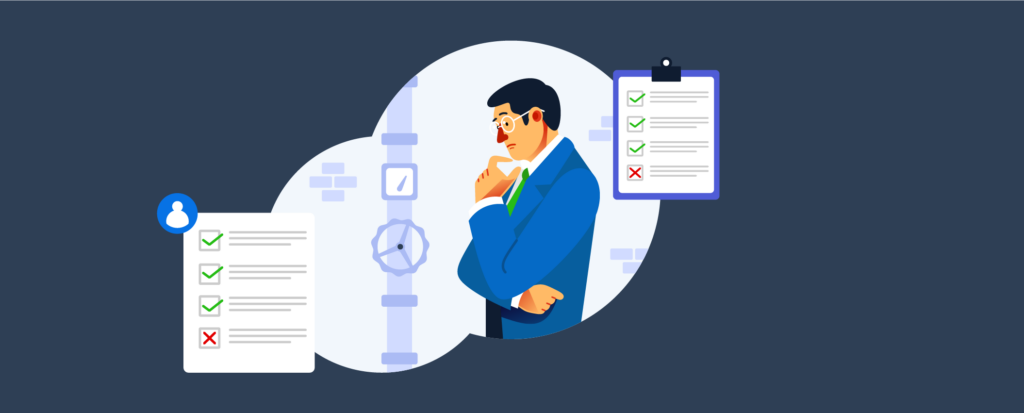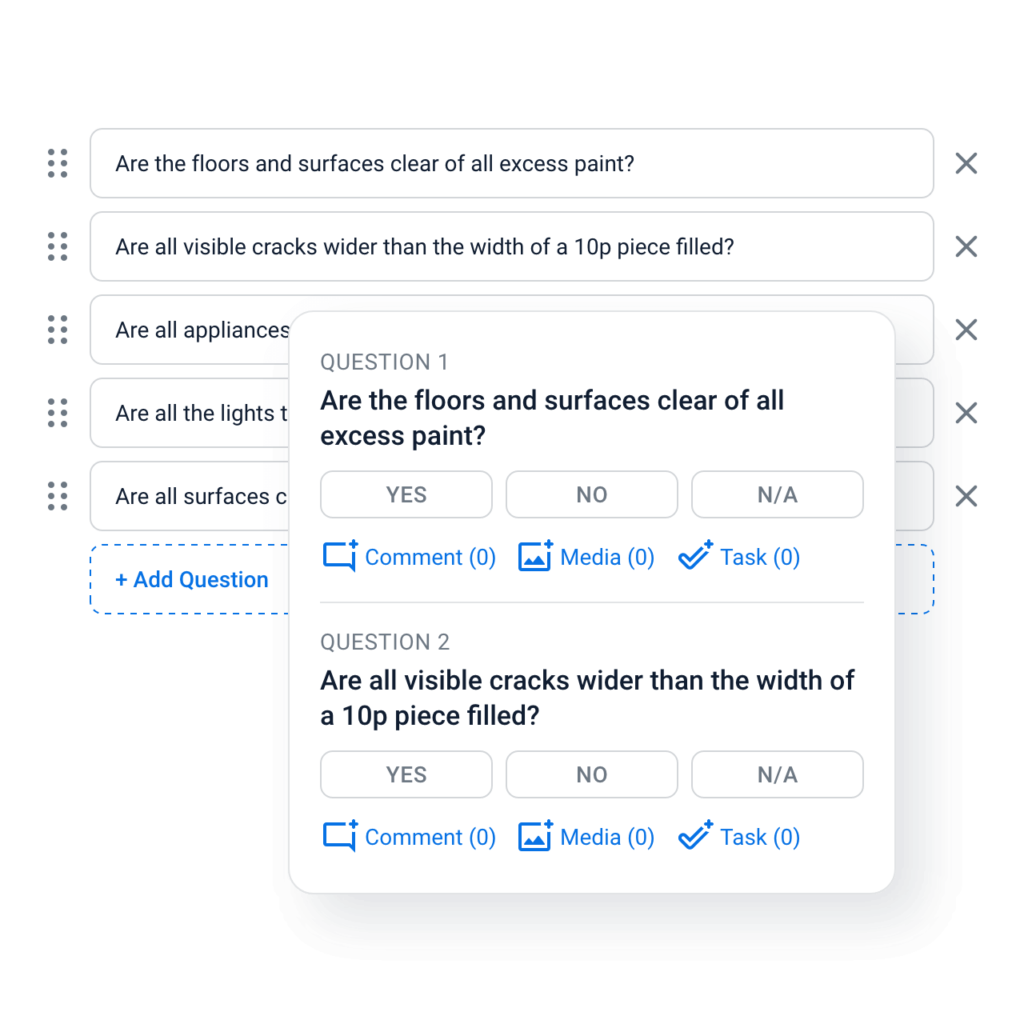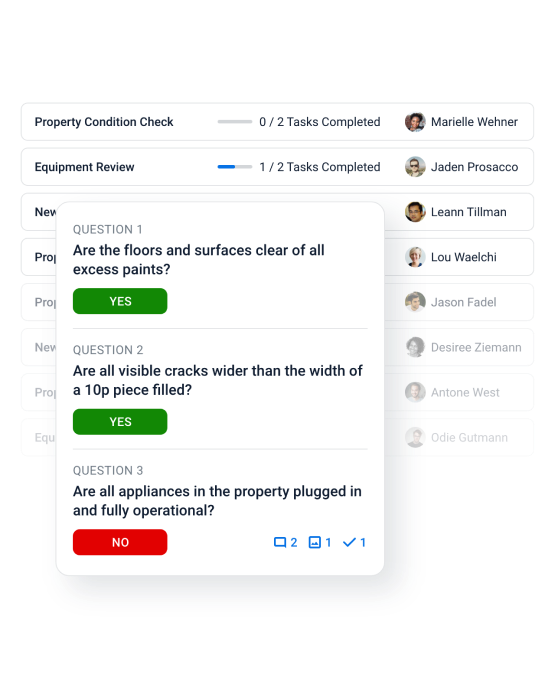

Whether you’re an independent certified property inspector or you’re part of a company that manages property inspections routinely, conducting property inspections can be a handful to manage.
Even experienced property inspectors can feel overwhelmed by the amount of processes needed to meet a high standard of performance.
This is where it can be handy to have property inspection checklists and tools that make inspections easier.
In this article, we’ll explore what property inspections are, their purpose, the common checklists for property inspections, plus tips and tools that can make real estate property inspections a breeze to conduct.
A real estate property inspection is an inspection of a property for the purpose of determining its condition. Although it is also known as a property inspection, these inspections can also be conducted for commercial properties.
Property inspections are important because they provide information about the condition of a property.
When it comes to buying and selling a property, this information can be used by the potential buyer or seller to make decisions about whether to purchase, sell, or repair the property. Property inspections can also be used to regularly evaluate a residential or commercial property status and determine if the property needs renovations or safety maintenance.
Since it is a neutral report that can be used for valuation purposes, financial decisions, or even as evidence in the court of law, property inspections need to provide an accurate picture of the property’s condition.
As such, it is important that those in charge of property inspections have a checklist for every major category of an inspection to make sure nothing critical is missed out.
In the next section, we’ll cover the basic checklists you need to have.
Property inspections can be divided into the major categories below.
Take note that these categories are a basic overview and are not comprehensive. Different types of inspection may have different components to meet specific goals.
Usually, each area of a property, such as a bedroom or a kitchen in a house, is inspected for each major category.
Not all of the above categories would be applicable to every area, so each checklist would be different for each area.
Here’s an example of what an inspection checklist could look like for a property based on the guidelines provided by the Newham Council.
The inspection checklist example above is just one of the many different types of inspection checklists that a property inspector would need when doing a property inspection.
One would also need a different checklist for other areas of a property, such as the kitchen, the roof, and the garden.
Checklists may also vary when it comes to old properties, or when it comes to different types of property inspection with different primary inspection goals.
For example, an environmental property inspection would need to include processes to identify the presence of asbestos, lead, legionella, and hazardous substances.
With all these variations, it can become a paperwork nightmare to keep track of inspection reports.
There will be multiple forms per property, and if you are inspecting multiple properties a week, this can add up to stacks of paperwork.
Keeping this paperwork organised will in itself be a time-consuming task. Compiling them into a report will be an additional time-consuming task.
This is why a lot of property inspectors have made the switch to mobile inspection apps like Workflows.
Here’s a simple guide on how to move from Paper to Digital Inspections in 5 Simple Steps.
Here are a few reasons why mobile inspection apps have become a tool of choice for property inspectors.


First, inspectors need to make sure they print out and bring the right forms before going to a site. Making the mistake of bringing the wrong forms to an inspection site can lead to a lot of unnecessary time lost.
Second, filling out the forms by hand is tedious, especially when it comes to updating a report. Making corrections or adding something new to the report can lead to a messy report with scribbles and small handwriting that is difficult for their supervisors to read.
Third, without the advantage of digitally attaching a photo to the report, inspectors have to spend more time describing the issue—and even then, they may not be able to capture the problem in the same way a picture can.
Fourth, supervisors spend a lot of time filing physical inspection reports. Searching for a specific report or issue is also time-consuming. Thus, following up on corrective actions to resolve issues becomes a slow process because supervisors are held back by the manual search and organising process of a physical filing system.
Last but not least, manual inspection templates are difficult and costly to update because of the reprinting and redistribution involved.
When using software to complete inspections, all of these issues disappear.
Property inspectors can access any inspection template from their mobile phones at any time, complete inspection forms with just a few taps and entries, and edit reports without worrying about space or readability issues.
Supervisors on the other hand will have all submitted inspection reports automatically organised in the software. Searching for specific reports by date, location, keyword, or unresolved issues is also a breeze.
When it comes to making template updates, a supervisor can simply edit an existing inspection checklist template or upload a new one, and all property inspectors can access the latest updates immediately.
The manager can then easily track and follow up with the responsible person to make sure that the measures have been implemented within a reasonable timeframe.
Switching to a mobile inspection app like Workflows can simplify the entire property inspection process while improving the quality of the inspection too.
Here are a few other additional tips from industry experts that can help your employees conduct property inspections with greater ease.
For example, conducting biannual inspections of rental properties can help preserve or increase the property value, identify issues that need maintenance or repair before the damage gets worse, increase tenant retention, confirm no illegal activity is conducted on the premise, and prevent void insurance coverage.
Managing your property inspections digitally through a mobile app makes it easier for you to schedule regular inspections for each property in your portfolio.
Being late or inaccurate in a property inspection evaluation could affect the process, which may disappoint the parties involved. This is where the advantages of mobile inspection apps can also turn into a competitive edge.
If you’re interested to help your team of property inspectors easily complete property inspections through their mobile devices, talk to sales and find out how Workflows can be customised to meet all your property inspection needs.